Warming pushes lobsters and other species to seek cooler homes
In response to climate change, plants and animals are moving toward the poles, changing timing of important events and more
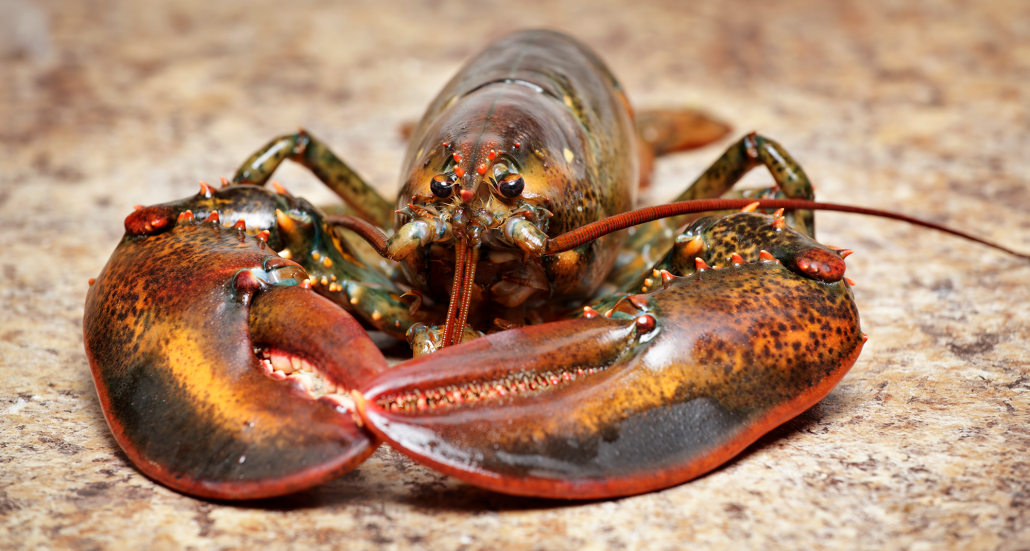
As climate change warms the Atlantic, the range of the lobster is shifting north. Lobsters are just one of many species around the world reacting to global warming.
temmuzcan/iStock/Getty Images Plus
This is the eighth in a 10-part series about the ongoing global impacts of climate change. These stories will look at the current effects of a changing planet, what the emerging science suggests is behind those changes and what we all can do to adapt to them.
Last August, the Gulf of Maine experienced a heat wave. Average water temperatures at the surface reached the second-highest level ever recorded: 20.52° Celsius (68.93° Fahrenheit). That’s still a bit chilly for any person who might go for a dip. And it’s even colder diving beneath the surface. But for lobsters, these conditions are absolutely balmy — and they’re loving it. A few decades ago, the Gulf of Maine was at the northern extent of the American lobster’s range. Now, as waters have slowly warmed, it’s prime territory, and lobsters are booming.
This has been great news for Maine lobstermen, like Kristan Porter. He fishes out of Cutler, Maine, on his boat the Whitney & Ashley, named for his two daughters. “I’ve seen not-so-great lobstering when I first started, and, you know, [I’ve] had a pretty good run over the last 25 years or so.”
Back when Porter first started fishing on his own, in 1991, temperatures in the Gulf of Maine weren’t ideal for lobsters, says Andrew Pershing. He’s an oceanographer at the Gulf of Maine Research Institute in Portland. But as climate change has warmed the planet — and its oceans — more and more, lobsters have migrated north. With rocky bottoms, kelp and other things that lobsters love, this is great lobster habitat, Pershing notes. Climate change has turned the gulf into a “paradise for lobsters,” he says.
But it won’t stay that way. Pershing’s research shows that if people don’t cut back on emitting greenhouse gases, later this century the waters here will become as warm as those now found off New Jersey, way to the south. And that’s “not a place you associate with a really robust lobster fishery,” he adds.
Maine lobstermen like Porter are starting to worry. They know that these good times might not last forever. “If things go down,” Porter says, “it’s going to be hard on those coastal communities” that depend on lobsters. The lobster fishery in southern New England has already collapsed, in part due to climate change.
As the Atlantic warms, lobsters are chasing their preferred water temperature. They’re spreading into waters that were once too cold for them, and leaving those that are now too warm. This movement is not unusual. Many, many other plants and animals around the world, both on land and in the sea, are also on the move. As a result, old ecosystems — communities of species — are falling apart, and new ones are forming. Some species will be winners. Others will be losers. This is also true for the people that depend on these ecosystems. Some, like the Gulf of Maine lobstermen, will benefit from these changes, at least for a while. Many others will lose out.
Just how all this will turn out is still a bit of a mystery. Scientists can’t predict how everything in an ecosystem will change as climate warms and weather patterns change. “But I think we should be prepared for some complicated responses,” says Janneke Hille Ris Lambers. She’s an ecologist at the University of Washington in Seattle. “All these species interact in these complex direct and indirect ways.”
The fingerprint of climate change
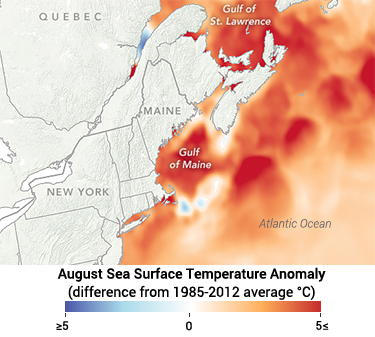
Last August’s record-setting heat in Maine wasn’t that unusual. Worldwide, temperatures have been rising. 2018 was the fourth hottest year on record, exceeded only by 2016, 2015 and 2017. Since 1850, global temperatures have risen by about 1 degree Celsius (1.8 degrees Fahrenheit), on average. Governments have agreed that they need to limit this rise to 2 degrees C (3.6 degrees F). But to do so they will have to make big cuts to greenhouse gases — and soon.
“People think that one or two degrees doesn’t make a lot of difference,” says Gretta Pecl. She’s a marine ecologist in Australia, at the University of Tasmania in Hobart. But even humans notice such a small change. She notes that her family is happy to lounge in their hot tub at 36 °C (96.8 °F) but finds that they all get out when it cools to just 35 °C (95 °F).
“Every animal has a temperature range that it’s comfortable in,” notes Pershing. Humans and other warm-blooded creatures can adapt somewhat to changes in temperature. But in creatures like the lobster, body temperature is dependent on their environment. And local temperatures can affect many areas of their physiology (FIZZ-ee-OLL-oh-gee), such as how active an organism is and how fast it grows.
Where something lives depends on more than just temperature, though. A species needs the right habitat, including food and space to raise young. How much or little rain falls can matter, as can a huge number of other factors. So if one species moves north, not all of the other species in its ecosystem may find that new location to be a good home. Despite this, it is clear that species around the world are shifting where they live, Pecl says. It’s not everything. But overall, between 25 percent and 85 percent of species appear to be changing where they live. Those figures, she adds, are “surprisingly high. And the patterns are surprisingly consistent.”
Animate Your Science/YouTube
The movement of all these species is “the fingerprint of climate change,” Pecl says, “but it’s a fuzzy fingerprint.” That’s because not everything is moving in the same way and at the same rate. Scientists are limited by their ability to detect all these changes. “But we are trying to make the best inferences we can,” she says.
Scientists can see that many species have changed their range. Depending on their hemisphere, they’ve been moving north or south, toward the poles. Species on land have moved an average of 17 kilometers (11 miles) per decade. Aquatic species are moving even faster, at an average of 72 kilometers (45 miles) per decade. Some terrestrial species have also moved up mountainsides, following their preferred temperatures. And a similar thing has happened in the seas, with some species moving to deeper, cooler zones.
Malin Pinsky is an ecologist at Rutgers University in New Brunswick, N.J. He and his colleagues have sought to look into the future. They’ve used computer models of future temperatures to see what might happen to ocean animals in North American waters throughout the next 80 years. The researchers focused on 686 species of sharks and other fish, crustaceans and cephalopods. Species would generally move north, they reported May 16, 2018 in PLOS ONE.
Some species, though, such as jack mackerel and canary rockfish, would move more than 1,000 kilometers (620 miles). In part, that’s because they can. They have the Gulf of Alaska and the Bering Sea to the north. But species in the Gulf of Mexico can only move so far. “If animals move to the north, they’ll end up on land,” Pinsky notes. That means such species could go extinct from the Gulf.
A long commute
Worth some $1.5 billion, North American lobsters (Homarus americanus) are big business. In fact, this is “the most valuable fishery resource in North America,” notes Pershing’s team. That provides a lot of incentive to look into the fishery’s health — and its likely future in a changing climate.
In the United States, lobster can be found from Maine down to southern New England, traditionally. But the lobster fishery in southern New England crashed around the year 2000. The Maine fishery, meanwhile, ballooned. Pershing and his colleagues wanted to find out why.
They created a computer model of the two fisheries. “We were able to … do the experiment of basically replaying the last 30 years of both the fishery in Maine and in southern New England,” Pershing explains. The model let them play with different factors, such as conservation strategies and warmer temperatures. “It allows us to kind of diagnose how important these different factors are.”
Temperature, they found, was a huge factor in the rise of Maine lobsters — and the decline of southern New England ones. The range of the lobster had shifted. Maine was once on the northern edge, but now it is in the middle. Those southern New England waters, meanwhile, are getting too warm. Pershing and his colleagues shared their finding in February 2018 in the Proceedings of the National Academy of Sciences.
As the climate continues to warm, though, the Maine lobster fishery could be threatened. That worries Porter, the Maine lobsterman, though he thinks he should be okay. The place where he sets his lobster traps isn’t great in the winter, so he catches other species during that time. If the lobsters decline, he says he should be able to catch other things and keep money flowing in. But for other fishermen, lobster is the only thing they catch. They won’t easily be able to switch to other species. So they could be hit hard, he says.
Fishermen elsewhere have already started adapting to climate change, Pinsky and his colleagues have found. The team analyzed patterns in fishing among commercial trawlers in the northwest Atlantic. (A trawler is a type of fishing vessel that uses a net towed behind the ship to catch fish, shrimp or other species.)
Since 1996, some ships have stayed close to home. These usually went after a diversity of species. Ships that went after only one or two species, in contrast, may once have trawled closer to home as well. But in recent years they’ve tended to travel a lot farther to get their target species. For instance, one fleet based out of Beaufort, N.C., has moved north at a rate of 21 kilometers (13 miles) per year. By 2014, they were traveling 433 kilometers (270 miles) farther north to catch the same fish than they did in 1996. Pinsky and his colleagues reported this January 1 in ICES Journal of Marine Science.
There are two ways to adapt to changing fisheries, Pinsky says: Go after the fish in their new homes, or go after the fish that have moved into local waters. Going after fish in their new homes could mean much longer sea journeys and require a lot more fuel. In the other case, fishermen will need to learn patience as they let the fish become established in their new homes. “In some cases, that might take a few years or even a decade,” he says. “Then they can support a really vibrant fishery going forward.”
Life gets complicated
As lobster, fish and other species have moved, it’s caused problems for humans and other species. Stinging jellyfish have moved into new waters. On land, bark beetles and other pests have invaded forests. There have been changes to the food supply. Diseases affecting people and other species also have emerged in new places.
Even traditional cultures may have to adapt. This can mean coming up with new words for new species as they move into an area. Or it can mean the loss of species on which a people has long relied.
Pecl notes that indigenous (In-DIH-jeh-nuhs) Tasmanian women have long used the shells of rainbow kelp snails when making beautiful necklaces for traditional ceremonies. “It’s a really important part of their culture and the way that they live,” she notes. But these sea snails are moving away from Tasmania, so their shells are disappearing. Tasmanian women don’t welcome finding replacements. It would require changing a tradition — one that has existed for thousands of years.
Project Puffin and Hog Island Audubon Camp/YouTube
Movement of species can drastically change a region’s food web, as well. Puffins live in the Gulf of Maine, along with lobsters. These birds prefer to eat herring, a fish that’s becoming less abundant. Butterfish, meanwhile, have moved in. “Unfortunately, butterfish don’t fit down the throat of a baby puffin very well,” Pinsky says. As a result, puffin chicks can starve to death.
Such changes in the food web can have unforeseen effects. Amanda Koltz is an ecologist in Missouri, at Washington University in St. Louis. The animals she studies are in the Arctic, which “is warming really fast,” she notes. “It’s warming at about twice the rate of the rest of the planet.”
As the Arctic warms, its permafrost is melting. That’s releasing a lot of carbon that has been frozen in the soil for sometimes thousands of years. This carbon can react with oxygen to make carbon dioxide. That’s a greenhouse gas that contributes to climate change. Plants and microbes can influence how much carbon gets released. But Koltz is interested in another part of the food web: predator-prey interactions. Animals may be a smaller part of the Arctic carbon cycle than plants and microbes, but, she notes, “in a lot of cases, the animals can matter. They can make a lot of difference.”
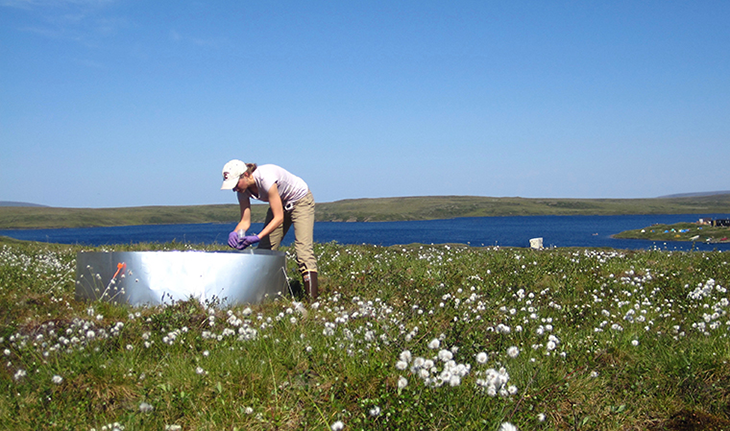
Koltz studies wolf spiders at a field station in Alaska. Insects and other arthropods, such as these spiders, “do really important things in an ecosystem,” she notes. They are herbivores, pollinators, predators and more. And they respond to changing temperatures more quickly than do vertebrates and plants.
At the field station, Koltz set up an experiment to see if what the spiders ate would change as the region warmed. And it did. The spiders ate fewer fungus-eating insects. That fungus controls decomposition in the Arctic soil. More surviving insects meant less fungus and a slower decomposition of materials in the soil. That should mean the soil would release less carbon into the air. Koltz and her colleagues published their findings last August in the Proceedings of the National Academy of Sciences.
“Who’s in the food web influences … the way that the food web processes energy and nutrients,” Koltz says. “We don’t know much about that, and we really have to be thinking about it more.”
HEC Science & Technology/YouTube
Flowers and the importance of timing
Hille Ris Lambers at the University of Washington is trying to understand such complexities in another ecosystem: wildflower meadows. Low elevations at Mount Rainier, in Washington, host a dense, old-growth forest. But meadows emerge above the tree line, where it’s too cold for trees to grow. In spring, those meadows bloom into a bouquet of wildfowers. “And if you’re there at the right time of year, [those blooms are] absolutely beautiful,” she says.
University of Washington/YouTube
Her lab monitors the meadows, tracking when various wildflower species bloom. The timing of flowering is an example of phenology (Feh-NOLL-uh-gee). This word, Hille Ris Lambers explains, refers to the fact that “the timing of important life events of organisms is often very seasonal.” When fresh, local peaches are available at the market is one example. Those peaches are ripe only during a brief part of the summer.
Blooming and fruiting times vary a bit for each species. Apples ripen at a different time than peaches, for instance. And different wildflowers on Mount Rainier can bloom at different times. Hille Ris Lambers has been finding that as the climate warms, when wildflowers bloom has been changing. But all species are not changing at the same rate. This means groups of species that once flowered together no longer do. “So where you might have had species A, B and C that always flowered early, maybe in the future you’ll have A, D and F.”
Temperature varies from year to year. So exceptionally warm years can offer a glimpse of the future. That happened in 2015. That year was as warm and dry on Mount Rainier as what is expected there in the 2080s. Different groups flowered together in 2015 than in other years, Hille Ris Lambers and her colleagues reported in the November 2017 Ecology.
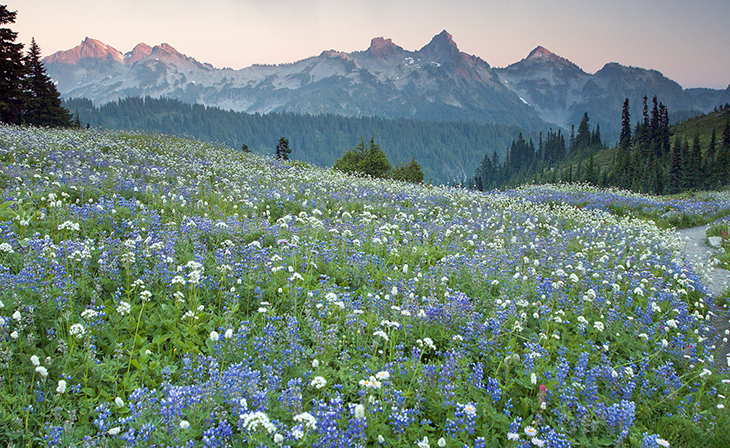
“When plants are flowering, they’re interacting with each other,” she says. Some compete for pollinators. Others can help each other out. So it matters for a plant what other species bloom when they do, drawing in pollinators. Those pollinators get food from the plants. And their activity — that pollination — affects how many seeds a plant can make.
Conservation matters
The story of the lobster’s success in Maine — and its decline in southern New England — is more complicated than just temperature, of course. A drop in the number of cod plays a role, as does a lobster disease.
In Maine, “climate change helped us,” says Porter the lobsterman. But good management of the fishery helped, too. A lot.
It’s common in fisheries to limit a fisherman’s catch to fish, lobster or other individuals above a certain size. That gives these species time to grow up and start making babies. But in Maine, there’s a maximum size limit, too. That means that the biggest and best breeders are left in the water to have even more babies. Maine lobstermen also mark female lobsters that are carrying eggs with a V-shaped notch in its tail. This v-notching lasts through several molts (when a lobster replaces its hard exoskeleton). So not only are the female and her eggs saved from getting eaten, but the lady lobster also gets more chances to breed.
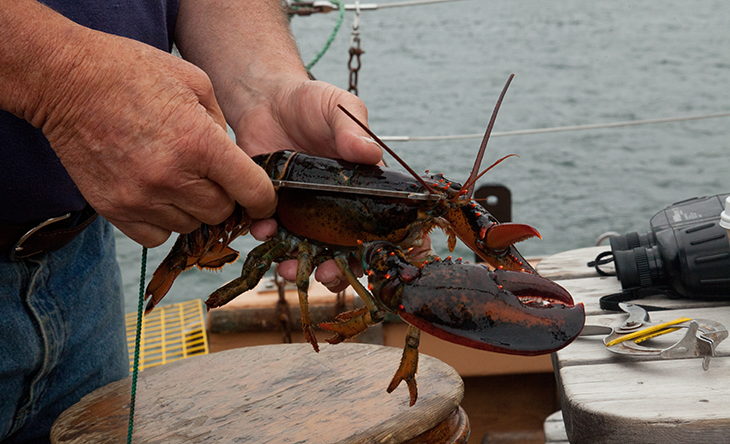
“One of the reasons why Maine has been able to take advantage of the warmer conditions is because [lobstermen] had been protecting the older, larger females,” Pershing says. He and his colleagues calculated in their modeling study that lobster in the Gulf of Maine increased by 515 percent between 1985 and 2014. But without the conservation measures, lobster abundance would have increased by less than half as much. And if the southern New England fishery had had similar measures, it would have decreased only 57 percent, instead of 78 percent. “Preserving large females can dampen the negative effects and amplify the benefits of warming,” he notes.
Other fisheries, such as cod, don’t have the same tradition of conservation that is embedded in Maine lobster culture. They also lack that stock of large, fertile females that give the Maine lobster fishery the resilience it will need as waters continue to warm. That could leave those other fisheries more vulnerable as pressures from overfishing, pollution and climate change all start to add up.
Resilience will help only so much. If greenhouse-gas emissions continue at present rates, eventually the water will become too warm for lobsters. “The clear thing we can do is reduce greenhouse gases,” says Pinsky. “With less warming, there’s less disruption to ocean ecosystems.”
But conservation can clearly play a helpful role. “Climate change is not the only way we’re affecting our environment,” notes Hille Ris Lambers. “All those stressors tend to act [together]…. If you can’t relieve one, relieving another would be helpful.”
Pecl agrees. “Ecosystems will cope a lot better if they’ve only got climate change to deal with.”







